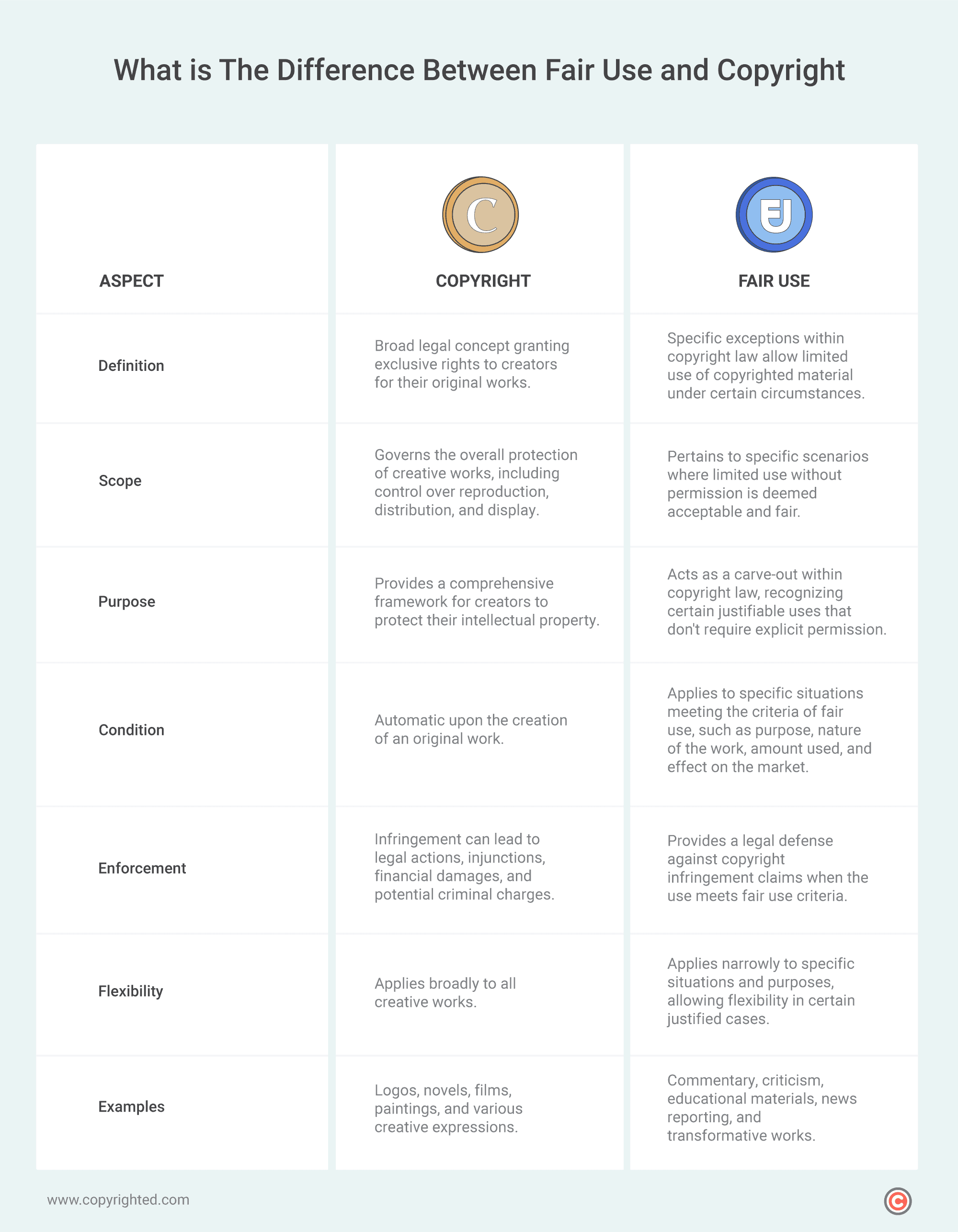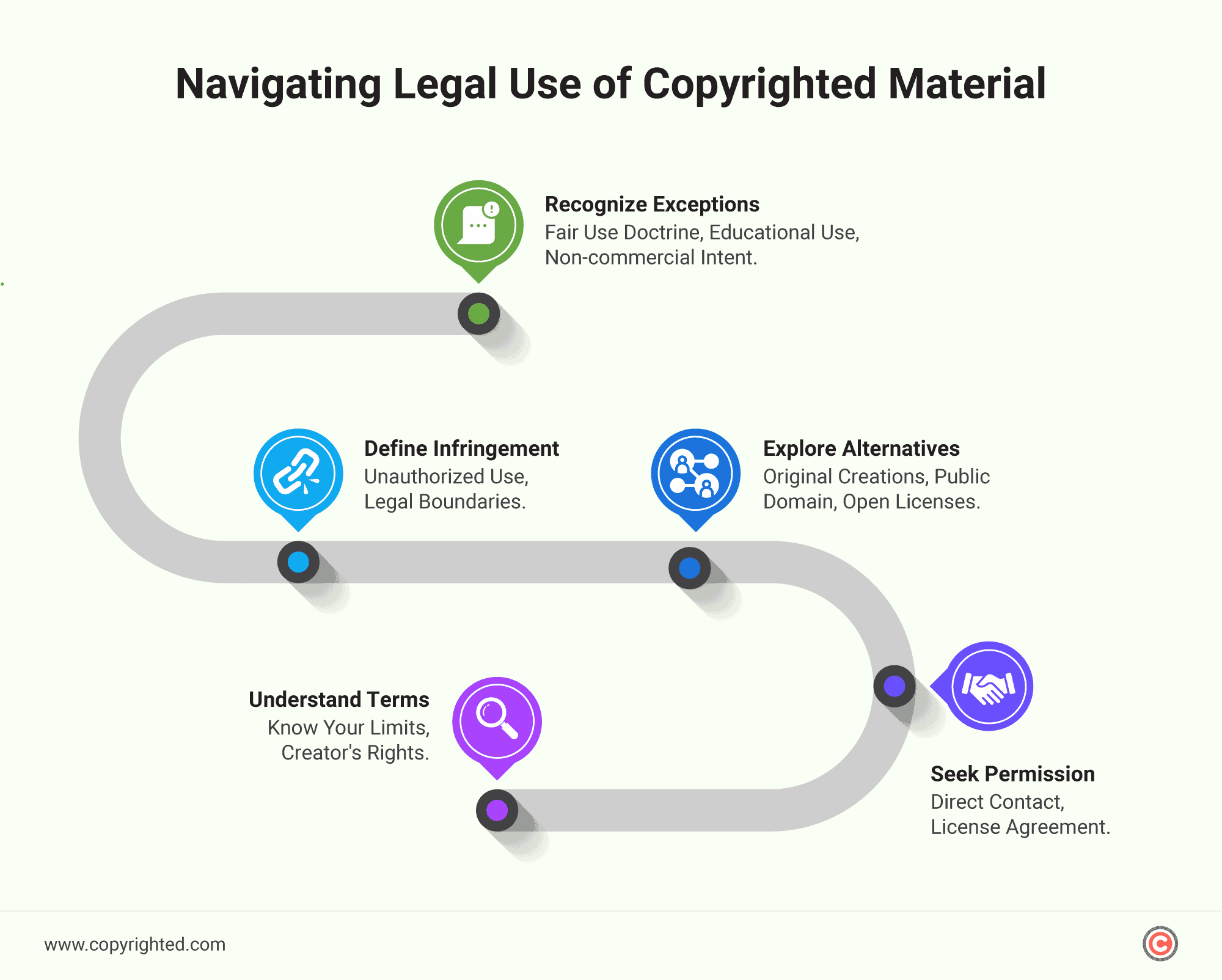Let’s simplify the world of copyright law.
Whether you’re a content creator, educator, media consumer, or managing a small online business, copyright is a realm you can’t escape. In an age of easy information sharing, it’s easy to get confused in the complicated landscape of copyright and fair use.
Not understanding the rules poses a significant risk. You can’t simply grab something online and hope to go unnoticed.
Copyright infringement is a serious legal matter that can jeopardize your career, reputation, and business. So, it’s important to tread carefully.
This article is your comprehensive guide to all things copyright and fair use. We’ll cover definitions, differences, examples, roots, and key determinants.
If you’re new to the world of copyright law and need a one-stop resource for essential concepts, you’re in the right place on the internet.
- Copyright is a legal concept that grants creators exclusive rights to their original works, including literary, artistic, and musical creations.
- Fair use is a legal doctrine that allows limited use of copyrighted material without permission, under certain conditions.
- The DMCA is a U.S. law that addresses digital copyright issues. It includes provisions for safe harbor and protects online service providers from liability for user-generated content.
Table of Contents
What is Copyright?
Copyright is a legal concept that grants creators exclusive rights to their original works, including literary, artistic, and musical creations. It includes a wide range of creative expressions and is automatically granted upon the creation of the work.
Whether it’s a blog post, a painting, or a melody, if you’ve created it, copyright likely applies, granting you exclusive rights.
Acquiring copyright is pretty straightforward – no complex rituals or paperwork are required. The moment you create something, you automatically become the rightful copyright owner.
Being a copyright holder means you have exclusive control over the reproduction, distribution, and display of your creation. It’s your personal and exclusive domain.
When it comes to duration, copyright protection is not indefinite.
It typically lasts for the creator’s lifetime plus an additional 70 years. After this period, the work enters the public domain, becoming free and accessible to use by anyone.
As for the consequences of deviating from the Copyright Law, legal troubles and severe fines await those who disregard and disrespect copyright boundaries. Staying compliant ensures a mutually beneficial scenario for everyone.
Examples of Copyright
Copyright is a practical necessity for creators and a cornerstone of intellectual property protection. Here are three vivid examples of copyright-protected works:
- Iconic Logos: Think of universally recognized logos like the Apple logo or the Nike swoosh – these symbols are not just brand identifiers but also copyright-protected creations, ensuring their exclusive use.
- Bestselling Novels: Literary masterpieces like J.K. Rowling’s “Harry Potter” series and Suzanne Collins’s “Hunger Games” are not only celebrated for their narrative prowess but are also shielded by copyright, preserving the author’s rights to their literary creations.
- Blockbuster Films: The cinematic world is rife with blockbusters such as “Star Wars” and “The Lord of the Rings.” These films, captivating audiences worldwide, are prime examples of copyright-protected creations, preventing unauthorized reproduction or distribution.
What is Fair Use?
Fair use is a legal doctrine that allows the limited use of copyrighted material without the copyright owner’s permission for certain purposes such as criticism, commentary, news reporting, teaching, scholarship, or research. This principle is designed to balance the rights of content creators with the needs of those seeking the use of a copyrighted work for certain purposes that are considered “fair”.
Section 107 of the Copyright Act provides that fair use of a work “for purposes such as criticism, comment, news reporting, teaching (including multiple copies for classroom use, scholarship, or research)” is not an infringement of copyright. To be certain if a particular use qualifies as fair use, the statute instructs that one should take into account the following four factors of fair use:
- Purpose and Character of the Use: Transformative uses are generally more likely to be deemed fair. Is the material repurposed in a way that adds new meaning, context, or message?
- Nature of the Copyrighted Work: The nature of the original work is also checked. Factual works may have more leniency under fair use compared to creative works.
- Amount and Substantiality of the Portion Used: Consideration is given to the quantity and significance of the portion used in relation to the entire work. Using only what is necessary for the intended purpose weighs in favor of fair use.
- Effect on the Potential Market: A critical factor is evaluating whether the use negatively impacts the market value or potential market for the copyrighted work. If the use undermines the commercial viability of the original work, it may be less likely to be considered fair.
Fair use is a flexible and essential tool, allowing creators to draw from existing copyrighted material to enhance their own work. It not only protects freedom of expression but also encourages a dynamic and creative landscape where new ideas can flourish.
Understanding why it is important to understand copyright and fair use is critical for anyone working with content—knowing the rights and limitations can help avoid legal issues while fostering innovation and collaboration.
Here’s a closer look at real-world scenarios:
- Commentary and Criticism: Imagine a video essay dissecting the cultural impact of a blockbuster film. The creator may incorporate clips from the movie to support their analysis, providing a transformative commentary on the original work.
- Parody and Satire: A comedic skit on a popular late-night show criticizing a hit song or a viral internet trend relies on fair use. Through humor and exaggeration, the creators add a new layer of meaning, ensuring their work falls under the umbrella of fair use.
- News Reporting: Journalists covering a breaking news event may incorporate copyrighted material, such as images or footage, to provide a comprehensive and accurate account. The use of such material in a news context is often protected under fair use.
- Educational Purposes: In an educational setting, a teacher might use excerpts from a copyrighted documentary to illustrate historical events or scientific concepts. This educational use is generally considered fair, as it serves a non-commercial, transformative purpose.
- Transformative Works: Content creators on platforms like YouTube often produce transformative works, such as remixes, mashups, or video essays. By repurposing and transforming copyrighted material, they contribute to a new, original creation, falling within the bounds of fair use.
It’s also important to understand the difference between fair use vs public domain. Fair use allows limited use of copyrighted material with some restrictions, while public domain material is completely free for everyone to use without any limitations.
This distinction is important for both content creators and users, guiding a thoughtful approach to handling the boundaries of acceptable use in the dynamic world of creative content.
Examples of Fair Use
Understanding fair use is best illustrated through real-world scenarios where this legal doctrine comes into play. Consider these three instances:
- Educational Presentation: A teacher incorporates a brief excerpt from a copyrighted documentary into a classroom presentation to enhance a lesson on environmental conservation. The use is transformative and serves an educational purpose, likely falling within the fair use guidelines.
- News Reporting: A news outlet uses a snippet of a copyrighted interview in its reporting on a significant event. The use of this material contributes to the accuracy and comprehensiveness of the news story, aligning with fair use principles for reporting purposes.
- Book Review Video: A content creator produces a video review of a recently published novel and includes short excerpts to support their analysis. The transformative nature of the video, which adds commentary and critique, aligns with fair use for literary review.
In these examples, fair use enables the responsible and constructive use of copyrighted material, encouraging educational, news-related, and transformative content creation.
What is the Difference Between Fair Use and Copyright
At its core, copyright provides the general framework for protecting creative works, while fair use acts as a carve-out within this framework, allowing for responsible and limited use of copyrighted material under specific conditions.
To gain a more comprehensive understanding of the distinctions between copyright and fair use, let’s take a closer look through the lens of a detailed comparison table.

Copyright and Fair Use Guidelines
Copyright guidelines serve as the foundational rules governing the use of creative works. They establish the exclusive rights of creators, encompassing reproduction, distribution, and display of their original content.
Copyright is automatic upon creation, providing legal protection without the need for formal registration. Understanding and respecting these guidelines are essential for creators, businesses, and educators alike.
Fair use guidelines, on the other hand, provide a significant exception within copyright law. This exception is dependent on factors such as the purpose, nature, amount, and effect on the market for the original work.
Fair use is not a one-size-fits-all concept. It requires careful consideration of these factors to determine its applicability in specific situations.
In academic settings, fair use principles play a key role in creating a more effective learning environment. Educators can leverage fair use for purposes such as classroom instruction, research, and criticism.
Fair use also extends beyond the academic realm to commercial use.
Businesses may utilize fair use for purposes such as commentary, parody, or transformative works in advertising or product development. However, the commercial context adds complexity and a careful assessment of fair use factors is necessary to ensure legal compliance and avoid copyright infringement claims.
In essence, both copyright and fair use guidelines form the backbone of ethical and legal content creation. Whether in academic or commercial settings, understanding these guidelines is essential for contributing to a responsible and creative landscape.
Using Copyrighted Material Legally

When it comes to incorporating copyrighted material into your projects, it’s essential to tread carefully to avoid legal pitfalls. Understanding legal use, seeking permission, exploring alternatives, and recognizing exceptions are key aspects of handling copyrighted material.
Let’s discuss these considerations:
- Legally Navigating Copyrighted Material: When integrating copyrighted material into your projects, it’s essential to do so within the boundaries of the law. This involves understanding the terms of use, acknowledging the rights of the creators, and ensuring compliance with copyright regulations.
- Seeking Permission and Licensing: If your project requires the use of copyrighted material, seeking permission and obtaining the necessary licenses is a critical step. This process involves reaching out to the copyright owner directly, outlining your intended use, and securing the legal permissions required for your specific case.
- Alternatives to Using Copyrighted Material: In some cases, it might be preferable or necessary to explore alternatives to using copyrighted material. This can include creating original content, utilizing works in the public domain, or leveraging content released under open licenses.
- Defining Copyright Infringement: Copyright infringement refers to the unauthorized use, reproduction, distribution, display, or adaptation of copyrighted material without the permission of the copyright owner. It occurs when someone violates the exclusive rights granted to the creator under copyright law.
- Exceptions to Copyright Infringement: While copyright infringement is generally prohibited, there are exceptions. Some common exceptions and limitations include the fair use doctrine, use of public domain works, educational use, and non-commercial intentions.
Fair Use Doctrines and Policies
To understand fair use better, let’s explore its history, basic principles, significant court cases, and how it intersects with the Digital Millennium Copyright Act (DMCA) in the digital age.
Historical Development of Fair Use
The roots of fair use extend deep into legal history. It traces back to English common law and became formalized in the United States through legal decisions and the Copyright Act of 1976.
This law outlines factors like the purpose, nature, and amount of the copyrighted work used, as well as its impact on the market. Landmark cases, such as Campbell v. Acuff-Rose Music and Sony Corp. v. Universal City Studios, have shaped fair use principles.
Key Principles of Fair Use Doctrine
At the core of fair use are fundamental principles that guide its application.
Central to these principles is the transformative nature of the material’s use, where the addition of value, commentary, or a fresh perspective becomes a determining factor.
The type of copyrighted work in question also plays a key role, with considerations differing for factual works compared to highly creative or fictional content.
Fair use further scrutinizes the amount of material used, emphasizing the acceptability of utilizing smaller portions for specific purposes such as commentary or criticism.
Lastly, the potential impact on the market for the original work becomes an important consideration, ensuring a balance between innovation, commentary, and creativity while respecting the rights of content creators.
Court Cases Shaping Fair Use Doctrine
Landmark court cases have played a key role in shaping and refining the contours of fair use doctrine, establishing legal precedents that guide how copyrighted material can be ethically and legally used. Here are a few illustrative examples:
- Sony Corp. of America v. Universal City Studios, Inc. (1984): Commonly known as the “Betamax case,” this landmark decision upheld the legality of home recording using VCRs. The court ruled that recording copyrighted television broadcasts for personal use was fair use, and this decision had a profound impact on the concept of fair use in the context of technology and personal consumption.
- Harper & Row v. Nation Enterprises (1985): This case involved the publication of excerpts from former President Gerald Ford’s memoir without permission. The court ruled against The Nation magazine, emphasizing the importance of the amount and substantiality of the portion used in relation to the entire work, and underscoring the significance of fair use in news reporting.
- Campbell v. Acuff-Rose Music, Inc. (1994): In a case involving the use of copyrighted material in a commercial context, the Supreme Court ruled in favor of 2 Live Crew, stating that their parody of Roy Orbison’s “Oh, Pretty Woman” was a transformative work and thus constituted fair use. This decision reinforced the importance of transformative use in fair use evaluations.
Overview of the Digital Millennium Copyright Act (DMCA)
Enacted in 1998, the Digital Millennium Copyright Act (DMCA) addresses the challenges brought about by new technologies, aiming to balance the rights of copyright owners with the need for innovation.
The DMCA has key provisions, such as the safe harbor rule, which protects online service providers from liability for their users’ copyright infringement under specific conditions. This is especially important for platforms hosting user-generated content, allowing them to function while safeguarding against copyright issues.
Another aspect of the DMCA focuses on anti-circumvention, making it illegal to bypass technological measures protecting copyrighted material. While this helps protect digital content, some argue it might limit users’ access for fair use purposes, raising questions about the balance between copyright protection and user rights.
As technology evolves, the DMCA remains a significant framework for digital copyright regulation, influencing how content creators, service providers, and users navigate the digital landscape.
The interplay between DMCA and Fair Use
The DMCA aims to protect copyright holders in the digital era by implementing anti-circumvention measures against unauthorized access and distribution of copyrighted material. However, this impacts fair use, which balances copyright protection with the public’s right to use material in specific contexts.
The anti-circumvention measures may limit users’ access for fair use purposes, raising complex questions about harmonizing these legal frameworks.
While the DMCA and fair use can align, conflicts arise when anti-circumvention hinders fair use practices, such as accessing content for education or criticism. The ongoing interplay between the DMCA and fair use underscores the challenge of balancing intellectual property protection with users’ rights for transformative use.
Frequently Asked Questions
Why should you register your copyright, and how do you do it?
Registering your copyright provides a formal record of your work’s creation, making it easier to enforce your rights in case of infringement. To register, visit the U.S. Copyright Office website, submit the necessary forms, and pay the registration fee.
Can you use copyrighted material for educational purposes without permission?
Yes, under certain conditions. Educational use may qualify as fair use, allowing limited use without permission.
How can you determine if your use of copyrighted material falls under fair use?
Assess your use using the four fair use factors: purpose and character, nature of the copyrighted work, amount used, and effect on the market. If your use transforms the material, uses a small portion, and doesn’t impact the market negatively, the use is more likely to be fair.
How can you navigate copyrighted material without infringing on rights?
To navigate copyrighted material legally, consider using public domain content, seeking permission from the copyright holder, or relying on fair use. Understand the specific rights attached to the material and adhere to legal guidelines.
What is the Digital Millennium Copyright Act (DMCA), and how does it impact fair use?
The DMCA addresses digital copyright issues, introducing anti-circumvention provisions and safe harbor for online service providers. While it aims to protect copyright, it can impact fair use by restricting access to content through anti-circumvention measures.


